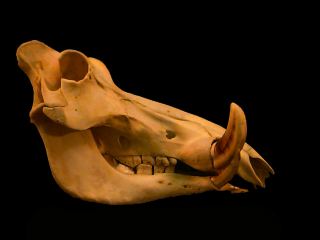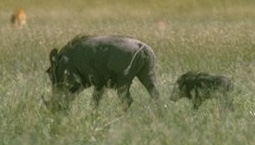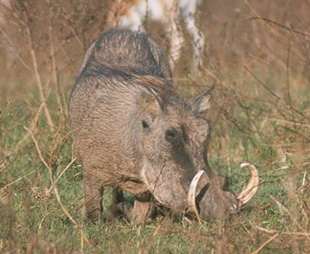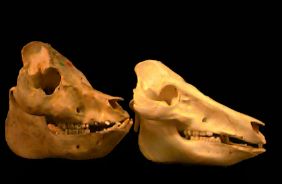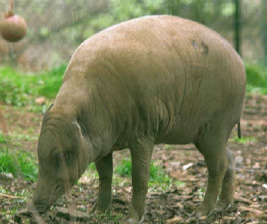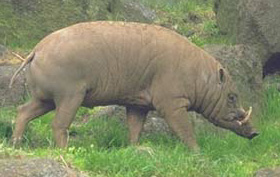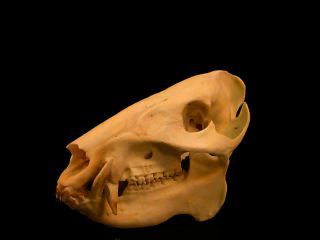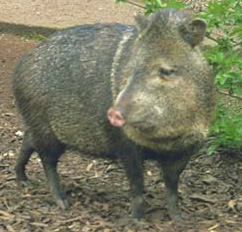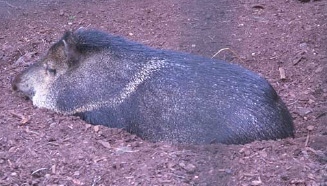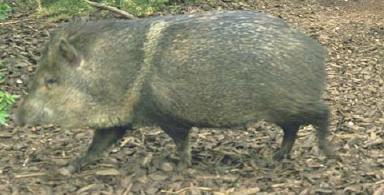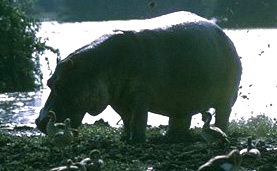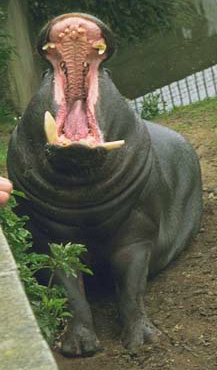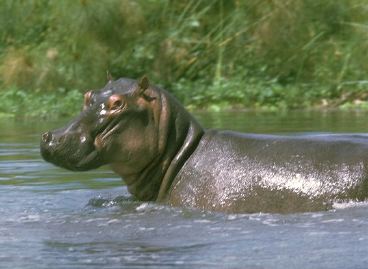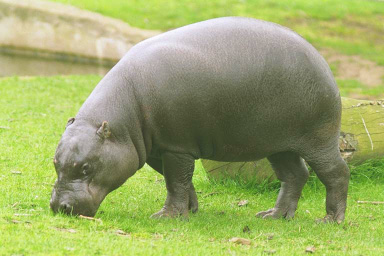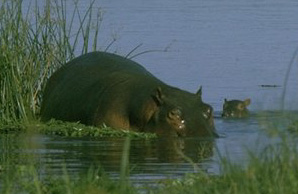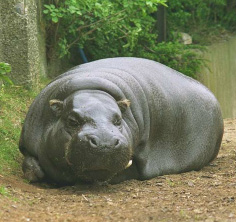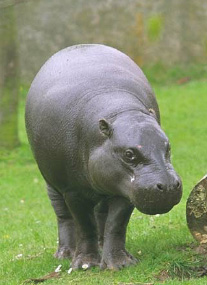
SUBORDER SUINA: PIGS, PECCARIES & HIPPOPOTAMI.
The Suina contains the earliest and most archaic artiodactyls. There are 3 families alive today: Family Suidae (pigs) Family Tayassuidae (peccaries) Family Hippopotamidae (hippopotamuses). The features shared by this group are:
The wart hog skulls show typical suid features. Both the upper and lower canines point upwards. The teeth are low-crowned relative to tylopod and ruminant artiodactyls.
Lateral toe reduction is less pronounced than in the peccaries.
Pigs are generally omnivorous, and are commonly found in forested habitats. Pigs have been known to eat leaves, seeds, roots, fungus, fallen fruit, grass, insects, birds' eggs, lizards and small mammals. Also, pigs are commonly active at night.The wart hog is one exception, it grazes on the African savannah and feeds on roots. It is only active during the day and will spend the night in dens, usually the abandoned burrows of other animals. The tusks are used for defence and in conflict between males. The more prominent upper canines are primarily for display. Most damage is inflicted by the sharper lower canines. The facial warts that give this pig its name help protect the face during these conflicts.
Pigs have a superb sense of smell and can easily locate food buried underground. The lead edge of the snout is hardened and used to dig with. The tusks are not used for digging.
Similar to pigs, peccaries differ from their close relatives in a few ways:
The peccaries became separated from other swine by crossing to the New World in the Oligocene.
There are three living species of peccary, the rarest of which is the chacoan peccary of the Andes ( Catagonus wagneri), only 'discovered' in 1975. All three species of peccary alive today are fairly similar. They are all omnivorous, with a similar diet to the pigs in the Old World. Peccaries also have a very sensitive snout and they will use their tusk-like canines to cut roots.
Peccaries are found in a variety of habitats in their range extending throughout South America and the southern portion of North America, including scrub, grassland, tropical forest and thorn forest. All species travel in herds of varying sizes and show cooperative defence. The peccary is hunted for meat, but the greatest threat to its future is habitat loss.
Compare the general shape of the peccary above with that of the tapir, a perissodacyl also found in the forests of South and Central America. Both are stocky, with short legs and a blunt snout.
Hippos have short legs with broad, four-toed feet to support their substantial weight and prevent their feet sinking too deeply into the mud. Most hippopotami, including extinct forms, belong to the genus Hippopotamus. Presently found only in Africa, Pleistocene hippos were found in Eurasia.
The skull shows typical hippopotamid features:
Hippos are found in pools, rivers and wallows during the day but emerge to graze at night. Hippopotamuses can walk along the bottom of rivers and pools on the tip of their feet. The smaller, more primitive pygmy hippo (Choeropsis liberiensis) is found in forested areas of west Africa. Pygmy hippopotamuses spend less time in the water, but their sensitive skin is at less risk from the sun because they live in dense tropical forests.
The hippo is at risk from the effect of climate change on its watery refuge. If the African climate becomes drier the pools and rivers will dry up, leaving hippos homeless.
Male hippopotamuses hold territories where they keep 'harems' of females. Groups of males, their females and calves can number nearly 150 animals. Pygmy hippos lead a solitary lifestyle. The only social group they will be found in is a mother with her calf.
Two pygmy hippopotamuses:
|







